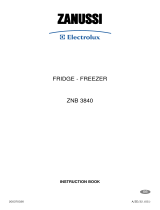
12
Fresh food refrigeration
To obtain the best performance:
do not store warm food or evaporating liquids in the
refrigerator;
do cover or wrap the food, particularly if it has a
strong flavour.
Position food so that air can circulate freely round it.
Useful hints:
Meat (all types): wrap in polythene bags and place on
the glass shelf above the vegetable drawer.
For safety, store in this way only one or two days at
the most.
Cooked foods, cold dishes, etc..: these should be
covered and may be placed on any shelf.
Fruit and vegetables: these should be thoroughly
cleaned and placed in the special drawer(s) provided.
Butter and cheese: these should be placed in special
airtight containers or wrapped in aluminium foil or
polythene bags to exclude as much air as possible.
Milk bottles: these should have a cap and should be
stored in the bottle rack on the door.
Bananas, potatoes, onions and garlic, if not packed,
must not be kept in the refrigerator.
Freezing fresh food
The 4-star compartment ( ) is suitable for long
term storage of commercially frozen food and for
freezing fresh food.
To freeze fresh foods it is not necessary to change the
setting of the thermostat knob.
However, for a quicker freezing operation, turn the
thermostat knob to the coldest setting; but remember
that, in this condition, the refrigerator compartment
temperature might drop below 0°C.
If this occurs reset thermostat knob to a warmer
setting.
To help you make the most of the freezing process,
here are some important hints:
the maximum quantity of food which can be frozen
in 24 hrs. is shown on the rating plate;
the freezing process takes 24 hours. No further food
to be frozen should be added during this period;
only freeze top quality, fresh and thoroughly cleaned,
foodstuffs;
prepare food in small portions to enable it to be
rapidly and completely frozen and to make it possible
subsequently to thaw only the quantity required;
wrap up the food in aluminium foil or polythene and
make sure that the packages are airtight;
do not allow fresh, unfrozen food to touch food which
is already frozen, thus avoiding a rise in temperature
of the latter;
lean foods store better and longer than fatty ones; salt
reduces the storage life of food;
water ices, if consumed immediately after removal
from the freezer compartment, can possibly cause the
skin to be freeze burnt;
it is advisable to show the freezing-in date on each
individual pack to enable you to keep tab of the
storage time;
on the inner door or special card (if supplied) you will
find sketches of various animals and food types
together with the recommended storage time (in
months) from the time of freezing;
do not put carbonated liquids (fizzy drinks, etc.) in
the freezing compartment as they may burst.
Storage of frozen food
When first starting-up or after a period out of use,
before putting the products in the compartment let the
appliance run for at least two hours on the coldest
setting, then turn the thermostat knob to the normal
operating position.
To obtain the best performance from this appliance,
you should:
If large quantities of food are to be stored, remove all
drawers and baskets from appliance and place food on
cooling shelves. Pay careful attention not to exceed
load limit stated on the side of the upper
section (where applicable).
make sure that the commercially frozen foodstuffs
were adequately stored by the retailer;
be sure that frozen foodstuffs are transferred from the
foodstore to the freezer in the shortest possible time;
not open the door frequently or leave it open longer
than absolutely necessary.
Once defrosted, food deteriorates rapidly and cannot
be refrozen.
Do not exceed the storage period indicated by the
food manufacturer.



















